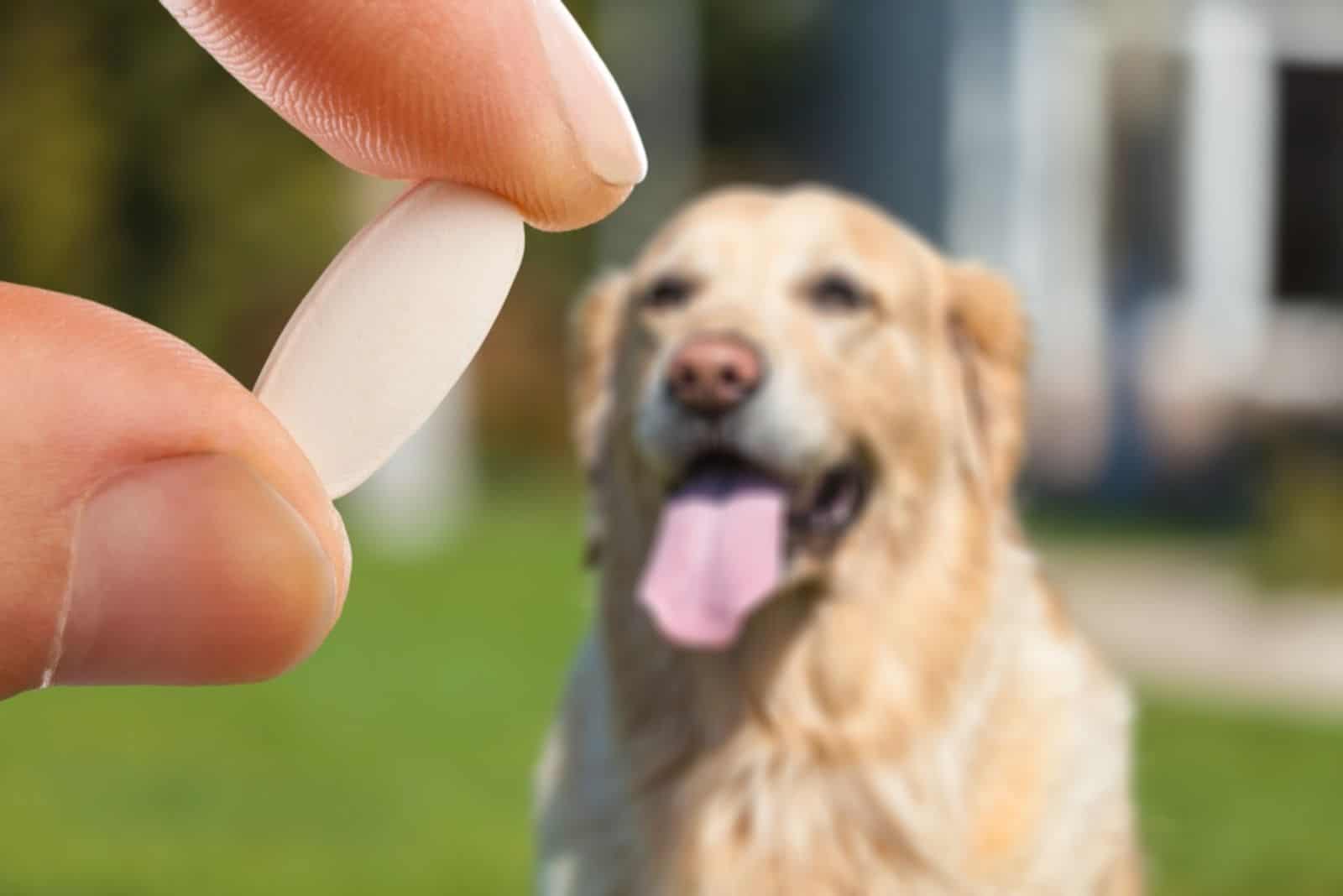There is a worldwide misconception that a fat Corgi is a cute Corgi. This doesn’t apply to Corgi dogs alone, it refers to all fat dogs around the world.
But we’ve all seen pictures of a Corgi butt on various social platforms with trending hashtags like “thicc” or “kawaii” following the picture. There have also been various Corgi butt stickers.
Yes, there is something adorable in chubby Corgis. They are cute dogs, but with that extra chubbiness, they become the epitome of cuteness!
However, being a Corgi owner (or just a dog lover or Corgi lover), we have to ask ourselves: Is a fat Corgi a problem?
Obesity in dogs is a serious health problem that can lead to numerous health issues that can shorten the lifespan of any overweight dog — Corgis included.
The happy Corgi is not a fat, overweight Corgi. They have an appropriate body weight depending on their age and activity levels.
So the questions come up: What to do when my Corgi is overweight? How to solve a fat Corgi problem? There are ways to solve the problem and help your doggy lose some weight.
A Fat Corgi Is a Problem
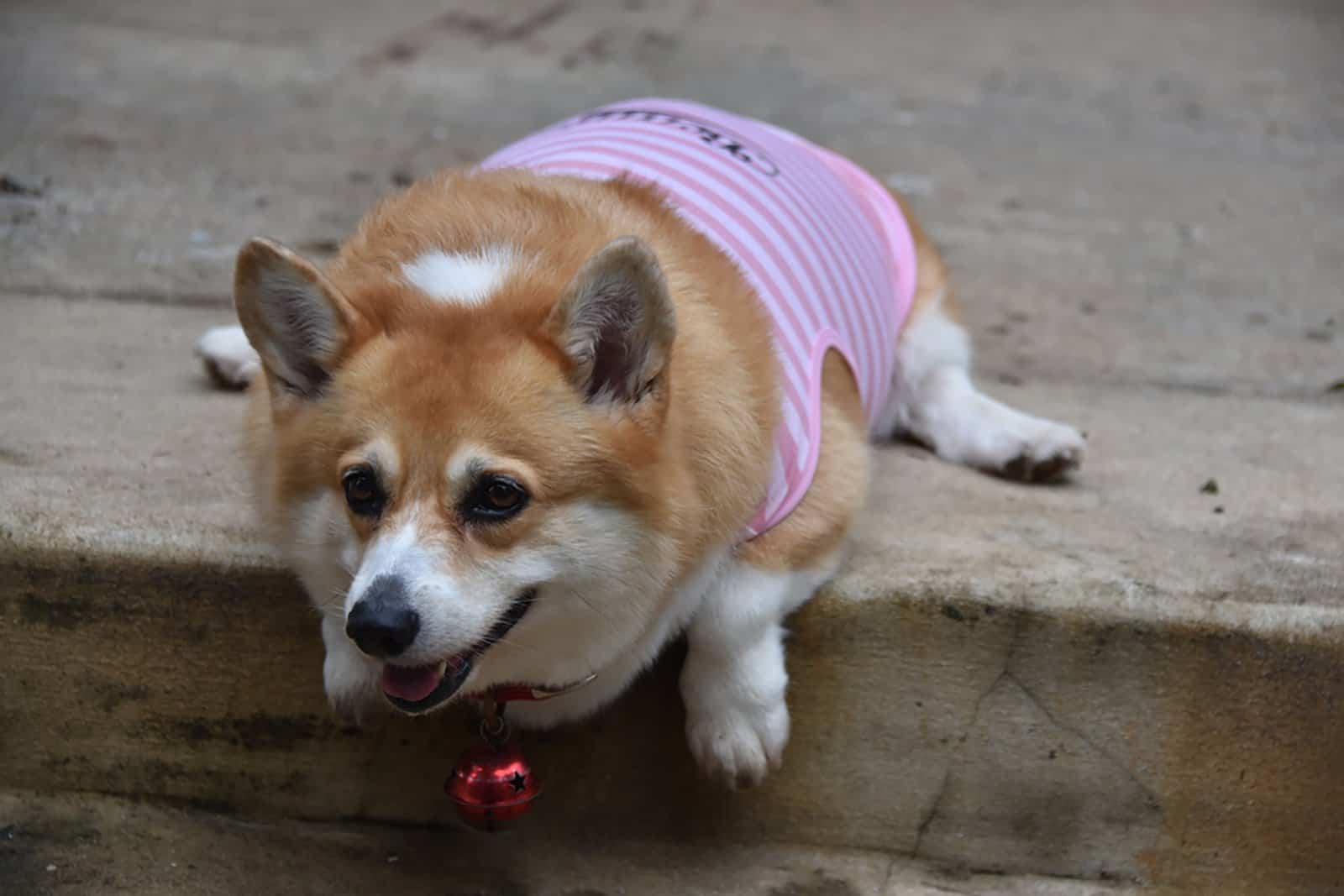
As we’ve mentioned, a fat Corgi does not have a normal body weight, and it is not a healthy Corgi, for sure. There are other dog breeds that are just as cute as Corgis. One of those dog breeds is the Shiba Inu.
They too go on the list of cute animals, especially on the list of cute puppies. A Corgi puppy is just as cute!
But as a new dog mom or specifically Corgi mom (or dad), you have to put your dog’s health first. Don’t worry; they won’t lose their famous Corgi butt when they lose a couple of pounds. They will stay just as adorable and fluffy.
Before we explain how to solve the overweight problem in your Corgi dog, what exactly is the Corgi dog breed? Let’s dive into that as well as what they should look like according to the American Kennel Club.
What Is A Corgi?
First of all, there are two types of Corgis.
One is called the Cardigan Welsh Corgi, and the other one is the Pembroke Welsh Corgi.
The one we are used to seeing on social media and all around the internet is the Pembroke Welsh Corgi (some websites write Welsh Corgi Pembroke), and it was the favorite dog breed of the late Queen Elisabeth II.
Even though they have been separate dog breeds since the 1800s, in general, they look very similar. One dog breed was bred and developed in Pembrokeshire and the other one in Cardiganshire.
However, Welsh Corgi breeders often mixed these two dog breeds, so today we have two Welsh Corgi dog breeds that look very similar with just a few physical differences.
One of the most important differences between these two breeds is their weight. The Cardigan Welsh Corgi weighs more than the Pembroke Welsh Corgi. That is especially important when you start planning your Corgi diet to help him lose weight.
Let’s take a look at a chart box to understand the differences between the Cardigan Welsh Corgi and the Pembroke Welsh Corgi better.
| Pembroke Welsh Corgi | Cardigan Welsh Corgi | |
|---|---|---|
| Body: | less stocky | more stocky |
| Weight: | up to 30 pounds | up to 38 pounds |
| Height: | up to 12 inches | up to 12.5 inches |
| Ears: | slightly rounded | slightly pointed |
| Tail: | docked | long tail |
| Color: | red, sable, fawn | various colors |
| Markings: | white | various markings |
The quickest way to see what Welsh Corgi is in front of you is to ask a question: Does this Corgi have a tail? If it has a long tail, it’s a Cardigan Corgi, if not, it’s a Pembroke Corgi.
No matter if they come from Cardiganshire or Pembrokeshire, both Welsh Corgis are prone to obesity and can more easily become overweight compared to some other dog breeds.
That being said, all dog breeds have their own AKC standards regarding their body weight, but variations are normal as long as they do not put your dog’s health in danger.
What Is A Healthy Weight For A Corgi?
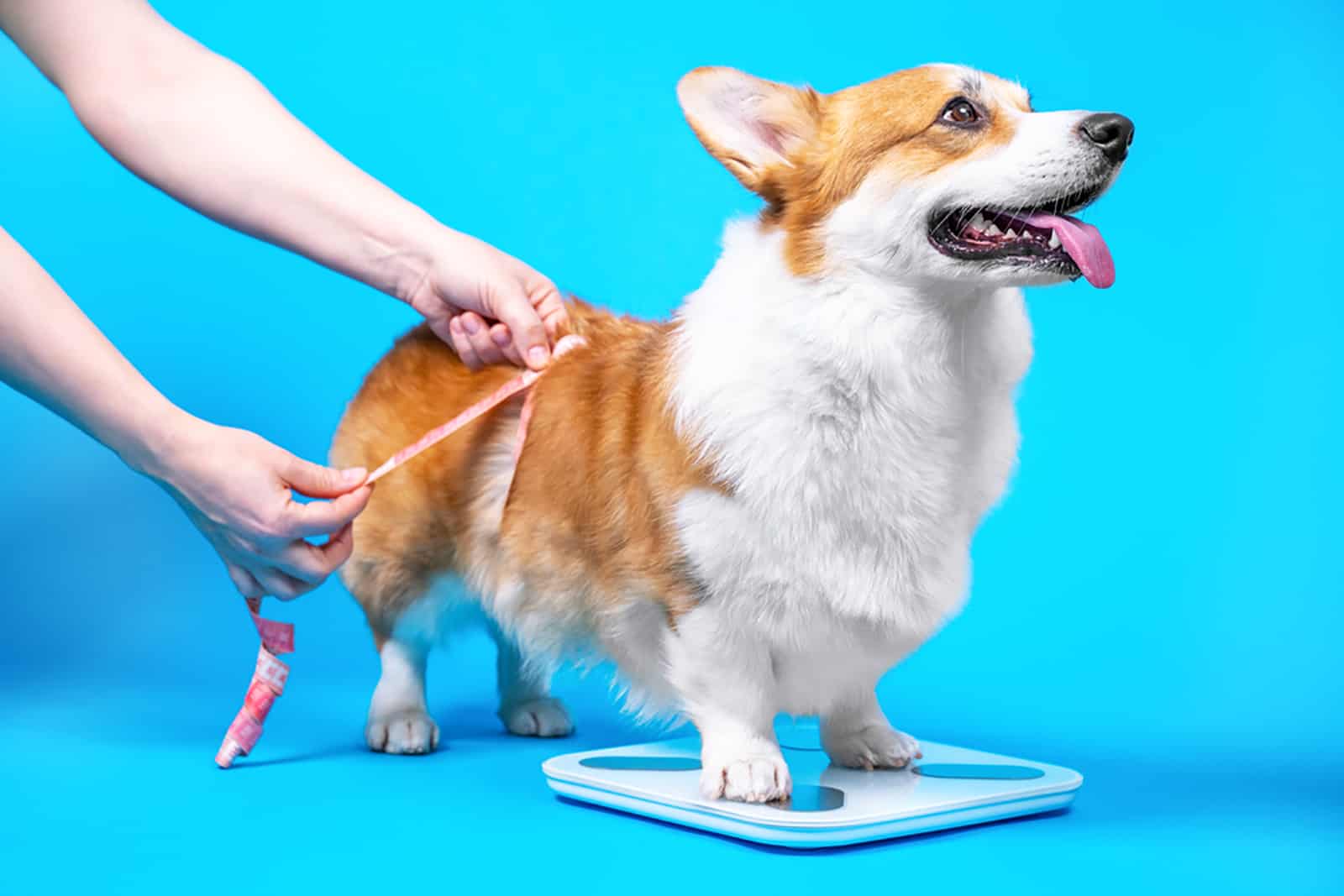
According to the American Kennel Club organization, the normal body weight of a Pembroke male Corgi is up to 30 pounds (13 kilograms) and up to 28 pounds (12 kilograms) for females.
For Cardigan male Corgis, the optimal weight is up to 38 pounds (17 kilograms) and up to 34 pounds (15 kilograms) for females.
If your dog is 32 pounds or 40 pounds if it’s a Cardigan Welsh Corgi, that doesn’t mean your dog is overweight. It means their body weight is higher than the average body weight accepted by the AKC.
The American Kennel Club has these average body weight and height norms in order to keep the dog breed pure, and they are mainly intended for dog shows where slight differences can impact the decision of who wins.
When it comes to any dog breed, a lot of dog owners are asking the same question: How heavy should my dog be?
We can’t compare the appropriate body weight of a Corgi with the Great Dane or some other big dog breed, but we can understand the needs and physiology of our own dogs so that we know what to expect during their growth.
To Worry Or Not To Worry?
If you have a Corgi puppy, there are some general rules when it comes to its growth.
You can even study some Corgi growth charts to better understand what to expect from your puppy, meaning how will the puppy develop, what weight is appropriate for which period of life, and basically — how big will it get?
You shouldn’t be worried if your female Corgi puppy of nine months weighs 22 pounds and the “normal” weight is 20 pounds.
Observe your puppy in the coming months; watch how they behave. Do they eat a lot and play less? Do they have problems with any kind of physical activity? If not, it’s okay.
But when should you worry? What is considered a fat Corgi?
When Is A Corgi Considered Overweight?
When it comes to deciding if your dog is overweight or not, we shouldn’t simply look at the numbers. There are other ways to check if you have a fat Corgi or not.
First, you have to accept the fact that your Corgi might have a problem. If you think all those cute photos of a fat Corgi are adorable and normal and you want to have a dog like that — you need to talk to your vet.
He or she can tell you from a professional standpoint why an obese dog is not a healthy and happy dog.
What Is Obesity?
Obesity (or overweight) is the excessive accumulation of fat tissue in all parts of the body. Obesity is a disease that is common in all mammals, but pets like dogs and cats are more prone to it.
They get obese because, in most cases, we enable them to get overweight. If there is no medical underlying issue making your dog gain weight quicker and easier, then we are the problem.
Dogs are considered obese or overweight when their weight is around 20% or more above the average weight.
How To Check If My Corgi Is Obese
The simplest way to check if you have a fat Corgi is to use the Body Condition Score for dogs. This is the score chart most vets use when they are assessing the dog’s weight.
The score goes from one to nine, with the ideal score being five.
You do this test by going over your Corgi’s body with your hands from the neck to the base of the tail.
If a dog scores one, two, or three on the scale, they are underweight. A score of one is the most serious condition where all the bony prominences are visible from afar.
With a score of two and three, you can feel the ribs and vertebrae under your hand with no palpable fat.
Scores of four and five are the ideal weight of a dog. It means you can easily feel the ribs with no excessive fat tissue surrounding them. If you look at your dog from above, the waist can be easily seen and the abdominal tuck is evident.
Scores from six to nine imply you have an overweight dog. Scores of six and seven are not that serious even though they are considered over ideal. But scores of eight and nine are cause for serious concern.
If your Corgi has a score of eight, it means you can’t feel the ribs under your hands because there is so much fat tissue surrounding the rib cage. There is also a lot of fat tissue in the lumbar area and at the base of the tail.
You can’t see the waist or the abdominal tuck either. There is also highly visible abdominal distention. The abdominal distention means your dog’s belly is bigger than normal and bulges out of a normal body line.
The highest score is nine. This body condition score means your dog has serious overweight problems. This is a true fat Corgi. You absolutely cannot feel the ribs because of the fat surrounding the whole body.
You can see obvious fat accumulation on the limbs and the neck too and a very obvious abdominal distention.
Fat Corgi — What to Do?
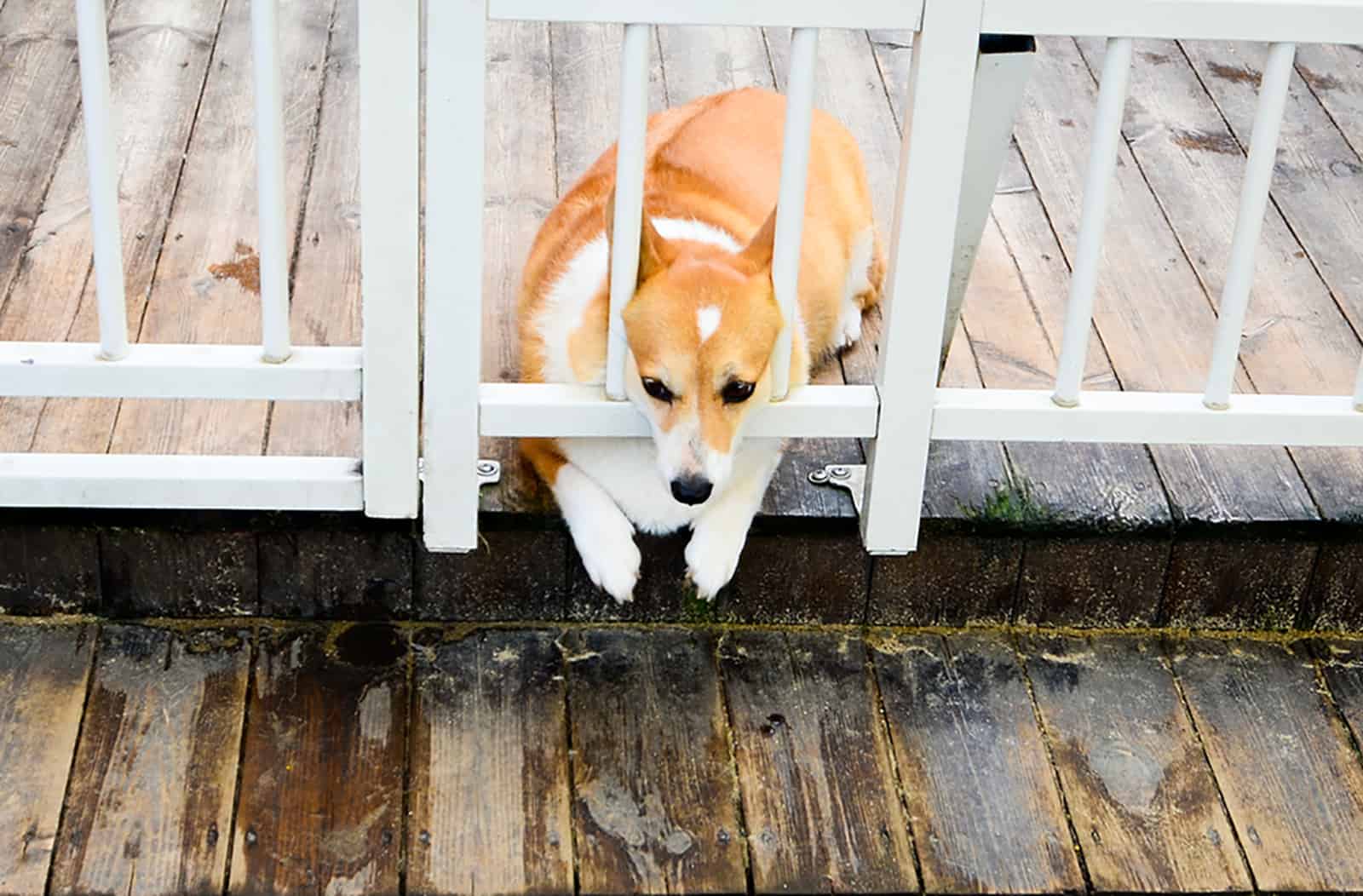
Okay, you checked your Corgi, and it turns out it is overweight. Don’t panic, there is a solution for a fat Corgi too. The first step is to take your dog to the vet and ask for a checkup.
They will certainly say the same thing if your dog already scored nine on a Body Condition Scale.
The vet can help you make a better diet plan for your fat Corgi, including the proper amount of food as well as recommendations on proper high-quality dog food to give your dog.
To sum it up, here are the things you can and should do if your dog is overweight.
1. Change Food
Dogs are carnivores just like their ancestors: wolves. The primary source of food for all members of the Canidae family is meat.
That means they are used to and need a lot of proteins for their body to function normally.
The food we give our dogs is mostly kibble. Dry dog food has its benefits, of course, but it can have some setbacks as well. The biggest setback of kibble is the number of carbohydrates.
The carbs are not bad ingredients, but if taken in larger amounts, it can lead to obesity — not only in animals but in humans too.
Just like you would change your diet to a low-carb diet to lose some weight, you should do the same for your Corgi.
Search for high-quality dog food for your Corgi. That means food that has a high protein percentage and low carbohydrate percentage.
This is the first and a very important step in dealing with obesity in dogs.
2. Change The Amount Of Food
This should be an obvious thing to do. You can’t expect your dog to lose weight if they keep eating the same amount of food every day.
Corgis, both Cardigan and Pembroke Welsh Corgis, are equally prone to obesity.
So the best thing is to adjust the amount of food you give them and check the available Corgi feeding charts to make sure your dog is getting the right amount of food daily.
The amount of food we give to our dogs depends on their age, health, and activity level. If your dog is not active at all, we should give them less food.
If your dog is still a developing puppy, the amount of food should be appropriate to the dog’s developmental needs.
In general, an adult Corgi needs one to one and a half cups of kibble daily. Also, you should make a feeding schedule. An adult Corgi should be fed one to two times a day.
The general rule is to reduce the amount of food you give to your dog by 5%. If you can’t see any changes in your Corgi’s weight, then reduce the amount by an additional 5%.
To be sure you are doing the best thing for your dog’s health, you can always check with your vet to see if you are giving the appropriate amount of food to your fat Corgi that needs to lose weight.
3. Add Supplements

When it comes to using supplements, you should always consult your veterinarian. They have information about the present supplement manufacturers that were proven to be the best for losing body weight in dogs.
The problem with supplements and the reason why you should consult the vet first is that supplements are not very well-regulated. This means that they can contain ingredients that can do more harm than good.
Supplements proven as good for weight loss are L-carnitine and fish oil. L-carnitine is an amino acid, and it helps your dog lose weight by using fat as an energy source for an activity. Fish oil has a lot of omega-3 fatty acids.
These acids have a special role in “burning” fat as well.
Combining these two supplements can give the best results as they are both considered to be generally safe to use with just minimal possible side effects.
Once again, always consult your vet before adding any kind of supplements to your dog’s diet.
4. Add Fibers
Fibers don’t have a lot of calories. They will make your dog feel full without influencing its body weight. And not only do they indirectly help your fat Corgi lose weight, they are good for his health too!
Fibers are very good for your dog’s GI (gastrointestinal tract) and overall health. Even though dogs belong to the already mentioned Canidae family that are carnivores, they need a bit of plant in their diet as well.
Have you ever seen your dog eating grass? It is an instinctual behavior that happens in other dominantly carnivore animals too (e.g. cats). Dogs need plants because plants consist of fibers that help them maintain a healthy balance in their bodies.
Adding fibers to your fat Corgi’s diet is good because they can eat larger amounts of food without gaining more weight. In fact, they will lose weight because fibers don’t have a lot of calories.
Where Can I Find Fibers To Give To My Dog?
Vegetables are rich in fiber. But you can’t give just any vegetables to your dog. You have to be careful because some vegetables can be very toxic to dogs.
Safe vegetables you can give to your doggy:
1. Carrots
2. Broccoli
3. Brussels sprouts
4. Celery
5. Green beans
6. Spinach
7. Peas
Vegetables you CAN’T give to your doggy:
1. Onions
2. Mushrooms
3. Leeks
4. Chives
5. Garlic
5. Exercise
This is another very important step in helping your fat Corgi lose weight.
Together with high-quality food rich in fibers and with the appropriate amount of food you give to your dog, exercise is the key to not only achieving the appropriate weight but maintaining it too.
Even though Corgis look like they were made to be companion dogs — especially the rare fluffy Corgi version (longhaired Corgi) — Corgis are not made for lounging on the sofa.
They are herding dogs with high energy levels, so it is okay to take your Corgi on a “more serious” walk, meaning a more active walk.
So how often should you walk your dog? Just consider the fact that all dogs must take at least one short walk every day! But your fat Corgi will need more than that. If your dog is refusing to walk, there are tricks to help both you and your dog.
For example, you can invite your friend that has a well-socialized dog to go with you on a walk.
Whatever you do, don’t use treats as a form of “bribe” to make your fat dog go on a walk. That would be like giving a cake to a person before they go to the gym.
You can use this trick for underweight or ideal weight dogs, but for fat Corgis, it’s counterproductive, and it creates a bad habit because they will expect a treat every time they go outside.
6. Remove Other Food Sources
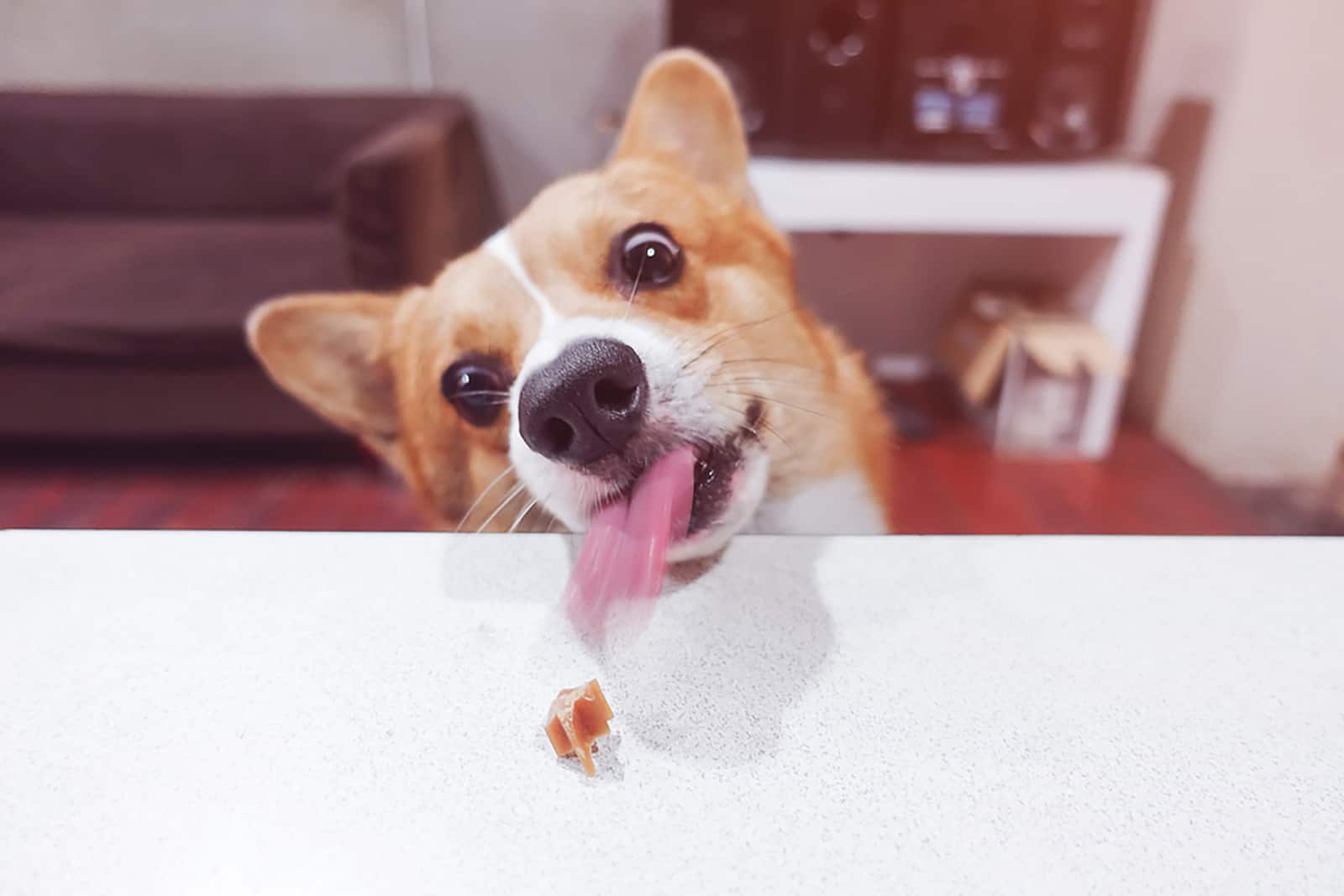
If you are planning on helping your fat Corgi lose weight, it is important to remove other food sources you might have at home too.
This is an especially important step if you have more than one dog. If you have one overweight dog and another one that has no problems, then you have to literally hide the food from your obese dog.
The best way is to feed them separately in different rooms so that there is no chance your fat Corgi can take a bite from his friend. Also, if you have a cat — hide the cat food too.
Some dogs love to nibble on cat kibble, and it can be a problem for both the cat and the dog. You can use some tricks to stop your dog from eating cat food. For Corgis, it can be as simple as putting your cat’s food higher up.
7. Remove Reward Treats
Treats are a good solution in dog obedience training if you have a dog with normal body weight. If you have a fat Corgi that needs to lose weight, they can’t have treats. It is as simple as that.
You have to find a way to reward them for good behavior without treats. Give them a pat, hug them, and ask them who’s a good dog several times, but don’t give them treats.
Giving treats often and giving a lot of them can make your dog obese, but it can cause another issue too — your dog can stop eating his food and eat only treats.
Instead of treats, you can use vegetables they love to eat. That way, you will give your dog a reward and make them happy and also help them lose weight by adding fibers into their diet.
8. Check For Medical Conditions
If you have a fat Corgi, you can take your dog to the vet and get him checked. There are various medical conditions that can lead to obesity in dogs, especially Corgis.
The common medical conditions that can lead to dog obesity are:
• Hypothyroidism
• Pancreatic tumors
• Cushing’s disease
• Neutering
Neutering does not directly lead to obesity in dogs. It is indirectly involved because after neutering, there are fewer sex hormones present in a dog’s body (male or female) which leads to slower metabolism and lower energy levels.
How Much Weight Should a Corgi Lose?
After realizing you have a fat Corgi and consulting with your vet, you can start planning your dog’s diet. But how much weight should they lose?
Once again, let’s go back to the Body Condition Score for dogs. You should aim for a score of five or at least seven. Also, don’t go for rapid weight loss. It can be very dangerous for the dog’s overall health.
Be patient. If you stick to the appropriate schedule, food amount, exercise, and add supplements to your dog’s food — there will be results!
Your end goal could be around 30 pounds for a Pembroke Welsh Corgi or around 38 pounds for a Cardigan Welsh Corgi. But again, don’t focus solely on the numbers. Look for clues on the dog’s body.
How much weight should your Corgi lose? Well, can you feel the ribs? Is there an abdominal distention? Can your dog even run without heavy breathing? All of these things can help you decide.
How To Maintain The Desired Weight
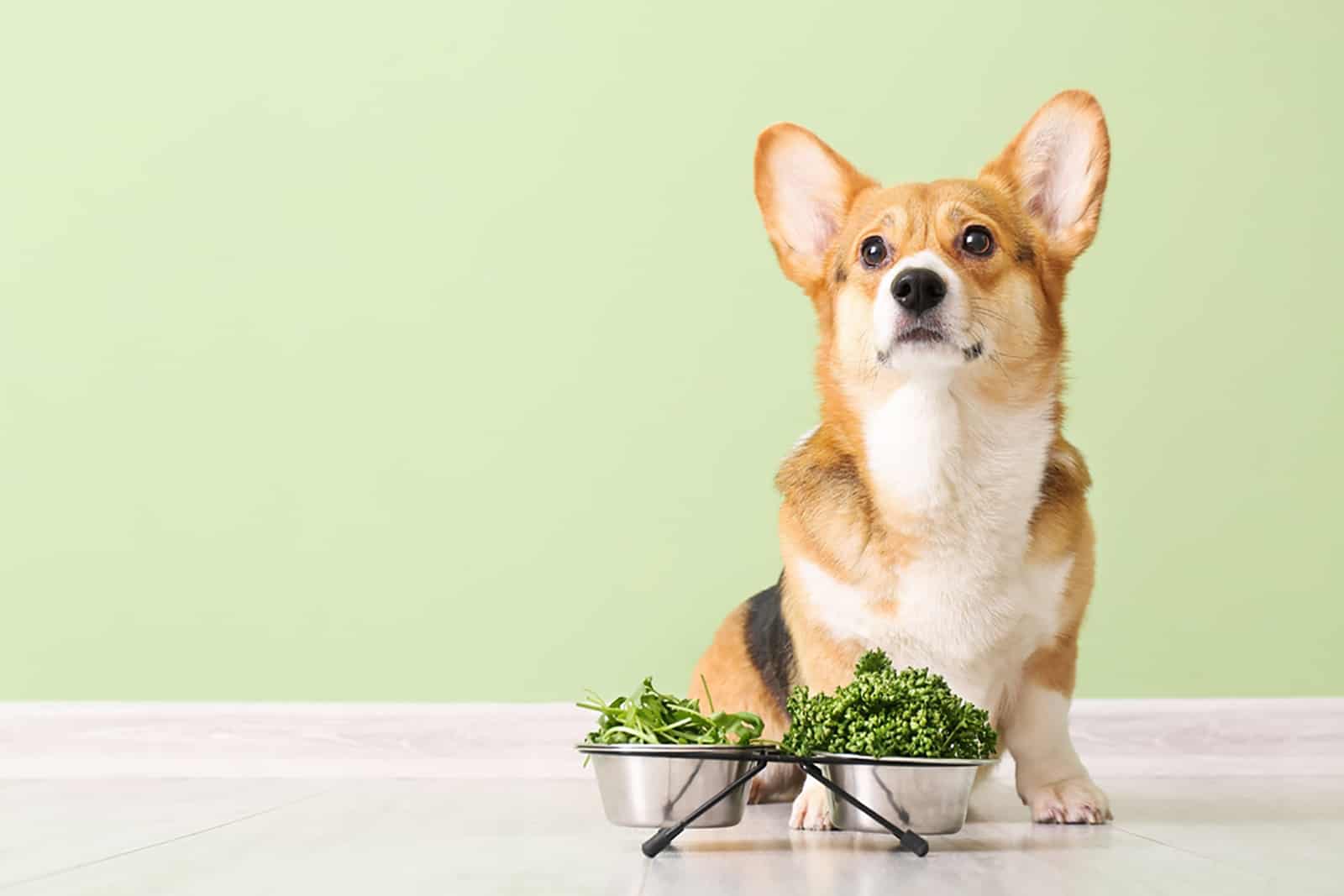
After you help your fat Corgi lose weight, that is not the end. You can’t just stop everything you have been doing and go back to the same old, same old.
You have to help your Corgi maintain the desired weight. Here are some simple rules to follow in order to keep your doggy an appropriate body weight:
• Continue monitoring food intake
• Continue feeding the dog high-quality food
• Continue keeping your dog active
• Continue adding fibers (vegetables) to their food
• Continue checking their score on the BCS for dogs
When your Corgi reaches the desired body weight, you don’t have to add any supplements anymore. However, it is important to continue with all the things mentioned above, especially the amount of food they eat and the amount of daily exercise.
Health Problems Connected to Obesity in Dogs
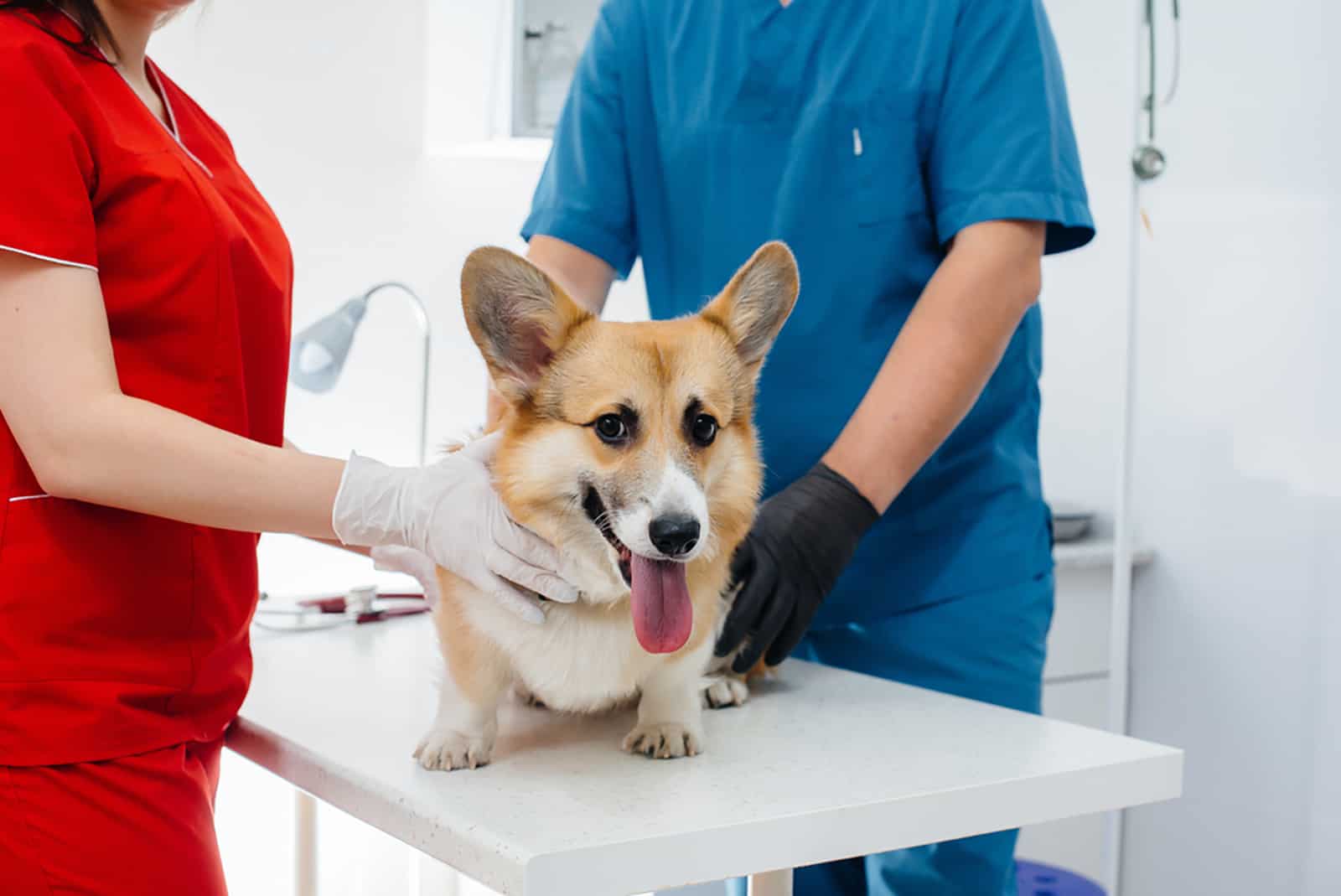
Obesity is proven to be a major contributing factor to some serious health issues in dogs. As dog owners, we want the best for our doggies. That means keeping them healthy and happy.
If obesity can lead to some dangerous health problems, we should do everything we can to help them lose weight.
Common health issues connected to obesity in dogs are:
• Diabetes mellitus
• Heart diseases
• Hypertension
• Bladder stones
• Osteoarthritis
• Cancer
• Anesthetic complications
The Conclusion
In general, a fat Corgi is not a good thing. They are just as cute without all that excessive fat tissue. We have to think about what is best for the dog and their health.
That includes feeding dogs appropriately in a way that ensures average body weight for both male and female Corgi dogs.
If you have a fat Corgi, not only are they prone to various health issues and conditions, but it makes their entire life harder and it shortens their lifespan. No one wants that. We want our doggies to live as long and as healthy as possible.
So let’s make it clear: A happy Corgi has an appropriate average body weight; it is not fat. A fat Corgi is a problem, and it needs to be solved through quality food, exercise, proper food intake, and supplements.













